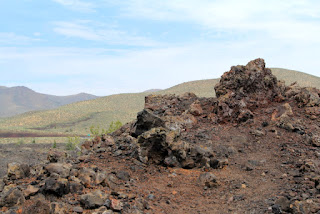Philo Farnsworth was born in a log cabin near Beaver, Utah, in 1906 and moved to Rigby, Idaho, when he was 12 years old. He developed an early interest in electronics and was noted for repairing old electrical equipment that other people had discarded.
One day when Philo was working in the potato fields he noted that the potato rows ran in straight lines across the field. This made him start wondering if it would be possible to take a picture, divide the picture into strips, broadcast the strips to a different location, and then reassemble the strips. He started making drawings explaining how this could be accomplished.
When Philo was in high school, his science teacher asked him about his project to transmit pictures and Philo provided the teacher with signed and dated drawings and an explanation of how it could be accomplished, The teacher was so impressed that he kept the information in his file because he thought it was such a great idea.
After Philo graduated from high school he attended Brigham Young University in Provo, Utah, and then attended the United States Naval Academy in Annapolis, Maryland. In his spare time he kept working on his television idea and when he learned that the government would own his patents if he stayed in the military, he applied for and received an honorable discharge.
He then moved back to Utah and then on to California where he received $6,000 from investors to continue working on his experiments.
RCA was interested in producing a television, so they hired Vladimir Zworykin who had been working on his own television system. On his way to RCA, Vladimir stopped by to see Farnsworth and was impressed with what Farnsworth was developing. When Vladimir arrived at RCA, he scrapped his ideas and had the lab construct several copies of Farnsworth's work. RCA then tried to hire Farnsworth, but Farnsworth rejected their offer.
Eventually, RCA and Farnsworth got into a patent dispute about who invented the television, and the case was appealed in the courts several times, with Farnsworth eventually winning the case. Apparently, the strongest evidence provided to the courts were the signed and dated papers that Farnsworth had given to his high school teacher, who had kept all of the information in his file cabinet and then gave it back to Farnsworth for his court case. The courts said that the papers clearly showed that Farnsworth had invented television!
To show his appreciation for the help of his high school science teacher, Farnsworth donated some of his original experiments to the Rigby High School. After a few years the High School became worried that their facility had inadequate security, so everything was moved to the Jefferson County Museum where it can be viewed today.
Before Farnsworth died, he also invented the first cold cathode ray tubes, the first simple electronic microscope, used radio waves to get direction (later called radar), and the black light for seeing at night (infra-red night vision). He held over 300 patents and was working on nuclear fusion at the time of his death. Time Magazine said that he was one of the 100 most important people of the Twentieth Century.
 |
| Photographer Unknown |
 |
| Photographer Unknown |
Idaho Falls, known for its famous traffic circle sculpture, is just a few miles southwest of Rigby and has a beautiful river walk with water falls, a Veterans Memorial, flowers, winding paths, views of the LDS Idaho Falls Temple, and many nice restaurants with outdoor patios.
Atomic City is located west of Idaho Falls and was once a thriving community when the Idaho National Laboratory was heavily involved in nuclear power generation research. Now, Atomic City is close to being a ghost town!
The first Experimental Breeder Reactor (EBR-1) was constructed at the Idaho National Laboratory near Atomic City and produced the first atomic energy used for peaceful purposes on December 20, 1951. EBR-1 is now open to the public for tours.
Arco (Idaho), located west of EBR-1, is the first town in the free world to be served by electricity produced by a nuclear reactor.
The USS Hawkbill sail (SSN-666) is located in an Arco park to recognize the work performed on the submarine's S5W Pressurized Water Nuclear Reactor at the Idaho National Laboratory.
The USS Hawkbill (SSN-666) was referred to as "The Devil Boat" because of a quote in Revelations Chapter 13 that states: "And I stood upon the sand of the sea, and saw a beast rise up out of the sea...Here is wisdom. Let him that hath understanding count the number of the beast for it is the number of a man; and his number is 666."
Most communities try to hide graffiti, but Arco is proud of the graffiti painted on a hill outside of town. They call it "Arco Number Hill" and every graduating high school class since 1920 has painted their graduating class year on the hill.
Craters of the Moon National Monument is an interesting place that contains a variety of cinder and splatter cones, lava tubes (some vertical), arches, fissures and rifts, pahoehoe (smooth lava), and 'a'a (crusty lava). The astronauts that went to the moon did part of their training here so that they could identify the different types of geological activity. I even climbed to the top of two cinder cones - the first one had log steps and the second one was a lot higher than it looked.
Located north of Idaho Falls near Spencer is the only place in the United States where you can dig for your own opals. Although you can not go into the mines, the owners bring materials to a location near the freeway where you can pay a fee and dig through the materials until you strike it rich! (Or, until you get tired, sore, and sunburned!)
As we were traveling north toward Salmon, we had planned to take a side trip to Lemhi Pass where Lewis and Clark crossed the Continental Divide, but we encountered some of the worst weather that I have seen in a long time -- high winds that were blowing over trees, plus rain and hail. Instead, we opted for a visit to the Sacajawea Interpretive Cultural and Educational Center the next day. This is the mountain area where Sacajawea was born and there are nice interpretive hiking trails, exhibits, and wild flowers along the Salmon River.
After crossing the 45th Parallel (halfway between the Equator and the North Pole) we arrived at the Land of The Yankee Fork Interpretive Center and the Challis Buffalo Jump. This is one of the locations where the Indians chased buffalo off of a cliff, which was an easier way to kill buffalo than using a spear or a bow and arrow. The area is now a State Park with a visitor center.
When we arrived in Clayton, the smoke from forest fires was really getting thick and we were informed that the highway ahead that went to Boise was closed. Since we were nearing the end of our trip anyway, we decided to turn around and head for home. However, we effeminately plan to return to the Land of the Yankee Fork at some future date!































































No comments:
Post a Comment